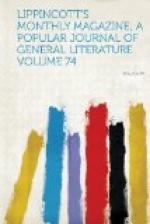palace, a labyrinth of tortuous streets and lanes,
not often visited by foreigners unless when bent on
some special expedition of sight-seeing. There
are no sidewalks for foot-passengers in these streets.
They are narrow, very tortuous and very crowded.
Foot-passengers and vehicles of all sorts find their
way along as best they may in one confused mass.
It was there I saw the historic pair of wheels in
question. They were attached to the barrow of
a coster-monger, who was retailing a stock of onions,
carrots and “cavolo Romano” which he had
just purchased at the neighboring market of the “Campo
de’ Fiori.” His wares, I fear, had
been selected from the refuse of the market, and he
and his barrow were in a state of dilapidated shabbiness
that matched his stock in trade. But not so the
wheels on which his barrow was supported. They
were wheels of the most gorgeous description.
The spokes and the circumference were painted of the
most brilliant scarlet, and the entire nave was gilded
so as to have the appearance of a solid mass of gold.
It is impossible to imagine anything more
bizarre
than the effect of these magnificent wheels doing
the work of carrying such an equipage. Nevertheless,
the apparition seemed to attract very little attention
in the crowded street. The grand scarlet and
gilded wheels flamed along among the crowd of shabby
men and shabby vehicles with their load of onions and
cabbages, and scarcely anybody turned his head to stare
at them. I suppose the denizens of the district
were used to the apparition of them. To me they
looked as if they had been the originals from which
Guido Reni painted those of the car in which he has
placed the celebrated Aurora of his world-famous fresco.
They were solidly and heavily built wheels—very
barbarous an English carriage-builder would have considered
them in their heavy and clumsy magnificence—but
they were very gorgeous. What could be the meaning
of their appearance in public under such circumstances?
I was walking with an Italian friend at the time,
who saw my state of amazement at so strange a phenomenon,
and explained it all by a single remark.
“Yes,” said he, “there go a pair
of His Eminence’s wheels. They are sharing
the fortunes of their late master in a manner that
is at once dramatic and historical.”
The wheels from a cardinal’s carriage!
Of course they were. How was it possible that
such wheels should be mistaken for any other in the
world? A few years ago, when pope and cardinals
had not yet suffered the horrible eclipse which has
overtaken them, one of the most notable features of
the Roman streets and suburban roads used to consist
of the carriages of the members of the Sacred College
taking their diurnal drive. It was not etiquette
for a cardinal to walk in the streets, or indeed anywhere
else, without his carriage following him. There
was no mistaking these barbarously gorgeous vehicles.
They were all exactly like each other, and unlike




